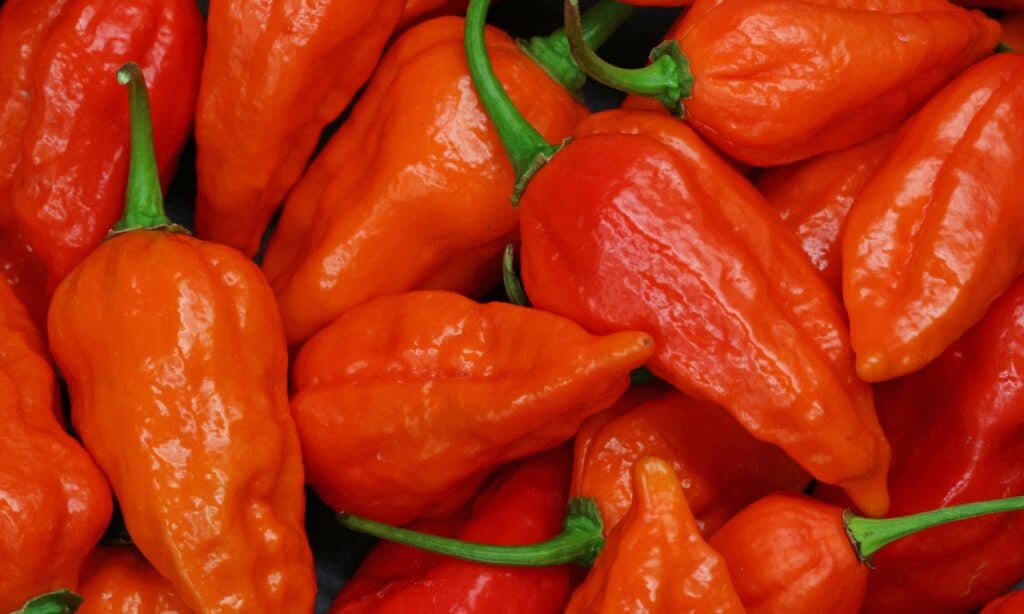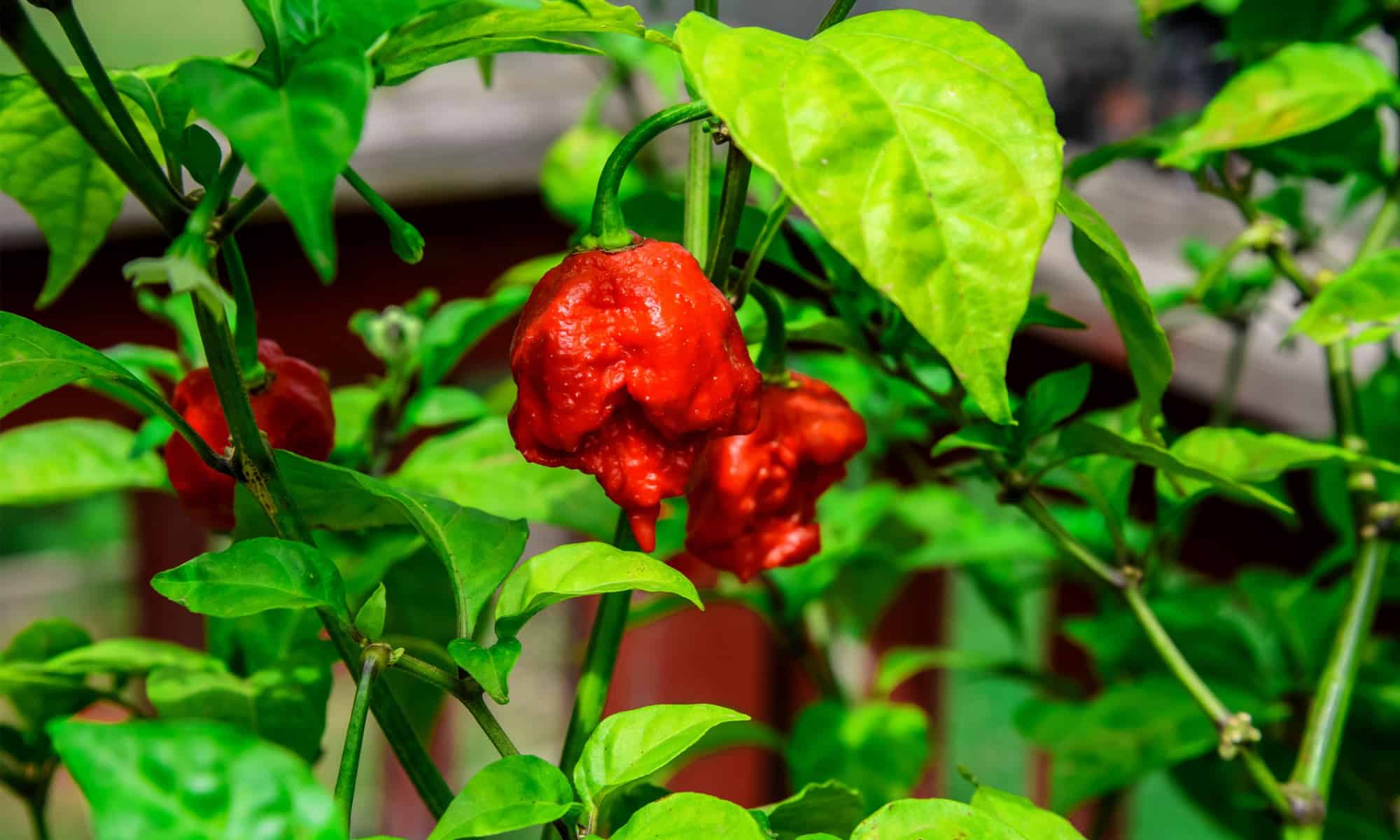In the world of chili peppers, where heat is the currency of respect, the ghost pepper stands as a fiery king. With a name that echoes its haunting potency, the ghost pepper, or bhut jolokia as it is natively called, has long been the subject of both fascination and fear.
Imagine a pepper so hot that it dwarfs the popular jalapeño by not double, not triple, but a whopping 400 times in terms of spiciness. Originating from the vibrant lands of India, this fierce chili has traveled across borders, making a name for itself in hot sauces and chili powders that dare to push the boundaries of heat. Join as we venture into the fiery depths of the Scoville Scale to uncover just how hot a ghost pepper truly is, and why it has become a benchmark in the spicy world.
How Hot Is a Ghost Pepper?
The ghost pepper confidently registers at 1 million Scoville Heat Units (SHU). To grasp this intensity, consider the popular jalapeño, a chili many are familiar with, which lingers around a comparatively mild 8,000 SHU. Even the fiery habanero, a pepper that’s often the upper limit for many, peaks at about 350,000 SHU.
In 2007, the ghost pepper was catapulted to international stardom, clinching the title of the world’s hottest pepper. Since then, it has been surpassed by other contenders, including the Carolina reaper, which leads with a jaw-dropping 2.2 million SHU. Even though the ghost pepper no longer holds the crown, it remains a legendary figure in the spicy food world, revered for its heat and its role in traditional Indian cuisine, where it adds not just heat, but a depth of flavor to dishes.

In 2007, the ghost pepper was catapulted to international stardom, clinching the title of the world’s hottest pepper.
©iStock.com/Andreas Häuslbetz
Comparative Heat: Scoville Ratings of Popular Chili Peppers
| Pepper | Scoville Heat Units (SHU) | Description |
|---|---|---|
| Bell Pepper | 0 SHU | Mild and sweet; lacks capsaicin. |
| Poblano Pepper | 1,000-2,000 SHU | Mildly spicy; used in Mexican cuisine. |
| Jalapeño Pepper | 2,500-8,000 SHU | Familiar heat; a pleasant kick. |
| Cayenne Pepper | 30,000-50,000 SHU | Common in spicy dishes; has a good punch. |
| Habanero Pepper | 100,000-350,000 SHU | Intensely fiery; for those who love serious heat. |
| Ghost Pepper | 850,000-1,041,427 SHU | Former world record-holder; extremely hot. |
| Trinidad Scorpion | 1.2 million-2 million SHU | One of the world’s hottest before being overtaken. |
| Carolina Reaper | 1.4 million-2.2 million SHU | Current record holder; the pinnacle of heat. |
What Are the Cons of Eating Ghost Peppers?
Ghost peppers, known for their extreme heat, can pose various challenges and risks when consumed. Here’s what to watch out for:
Stomach Discomfort and Digestive Issues
The high capsaicin content in ghost peppers can irritate the stomach lining, potentially leading to gastritis, stomach cramps, and severe indigestion. Overconsumption can even result in vomiting or diarrhea in more sensitive individuals.
Risk of Burns on Skin and Eye
Handling ghost peppers without proper precautions (like wearing gloves) can lead to capsaicin burns on the skin. Accidentally touching your eyes or other sensitive areas after handling these peppers can cause intense pain and discomfort.
Respiratory Irritation
Simply being around ghost peppers being chopped or cooked can lead to coughing, sneezing, or a runny nose. Inhaling the fine particles or fumes can irritate the respiratory tract.
Potential Allergic Reaction
While rare, some individuals might be allergic to ghost peppers or their compounds. Symptoms can range from mild hives or a rash to more severe reactions like shortness of breath.
Unexpected Intensity in Dishes
Using ghost peppers in cooking without understanding their potency can result in dishes that are far too spicy to consume comfortably. It can overshadow other flavors and make the meal unpalatable for many.
Long-Lasting After Effects
The burning sensation from consuming ghost peppers can last several hours. Additionally, some people experience a burning sensation during digestion and even upon excretion.

The burning sensation from consuming ghost peppers can last several hours.
©iStock.com/WorldExotc21
Recipes to Make with Ghost Peppers
Hot Sauce
To prepare this fiery condiment, you’ll need a few ghost peppers, which will be the star of the show. Combine it with other ingredients such as garlic, onions, carrots, and vinegar. Start by sautéing the garlic and onions until translucent, then add carrots and the peppers (with seeds and veins removed to temper the heat slightly). After a brief sauté, add vinegar and let the mixture simmer until the carrots are soft. Blend until smooth and season with salt to taste. Bottle it up and use it sparingly to spice up your favorite dishes.
Spicy Mayo
A spicy mayo can elevate sandwiches, burgers, or dips. To create this, start with a cup of mayonnaise as a base. Finely chop a portion of a ghost pepper – remember, they are extremely hot, so start with a small amount. You can always add more if needed. Combine the pepper with mayo along with a dash of lemon juice and a pinch of salt. Mix well and taste, adjusting the level of spice as needed.
Infused Oil
Infusing oil with ghost peppers is a way to capture its heat and essence, allowing you to drizzle its heated flavors onto various dishes. Begin with a cup of your preferred oil, such as olive or vegetable oil. In a saucepan, gently heat the oil but avoid bringing it to a boil. Add in two to three dried ghost pepper flakes (or more if you dare) and allow them to infuse on low heat for about 10 minutes. Remove from heat and let the oil cool. Once cooled, transfer to a glass bottle and store in a cool, dark place. Use this oil sparingly, as its potency can be surprising! It’s perfect for drizzling over pasta, pizzas, or salads.
The photo featured at the top of this post is © iStock.com/EvergreenPlanet
Thank you for reading! Have some feedback for us? Contact the AZ Animals editorial team.







